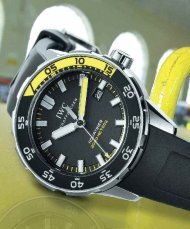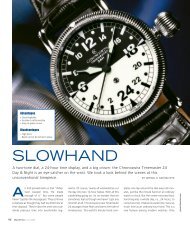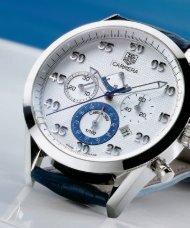WT_2004_05: CULT WATCH: AUDEMARS PIGUET ROYAL OAK
WT_2004_05: CULT WATCH: AUDEMARS PIGUET ROYAL OAK
WT_2004_05: CULT WATCH: AUDEMARS PIGUET ROYAL OAK
Create successful ePaper yourself
Turn your PDF publications into a flip-book with our unique Google optimized e-Paper software.
<strong>CULT</strong> <strong>WATCH</strong>: <strong>AUDEMARS</strong> <strong>PIGUET</strong> <strong>ROYAL</strong> <strong>OAK</strong><br />
INSIDE THE<br />
OCTAGON<br />
When the Royal Oak debuted in 1972, its launch was nothing short of<br />
revolutionary. Never before had a luxury watch been encased in steel.<br />
Although we’ve since become accustomed to this octagonal masterpiece,<br />
the Royal Oak still has the power to surprise.<br />
BY WITOLD A. MICHALCZYK<br />
88 WatchTime October <strong>2004</strong>
Dark clouds loomed in the skies above<br />
Switzerland’s watchmakers in the<br />
early 1970s. Although the first<br />
quartz watches from Japan were still rather expensive,<br />
they were the heralds of a trend that<br />
would cause an upheaval in the watch industry.<br />
A conflict that had already begun to smolder<br />
in the Near East suggested that a global oil<br />
crisis was imminent. The times seemed to be<br />
singularly unfavorable for new wristwatches in<br />
the world of haute horlogerie. Confronted by<br />
this inauspicious situation, the Audemars Piguet<br />
manufacture decided that the best defense<br />
was a good offense and debuted at the<br />
1972 Basel watch fair a timepiece that would<br />
come to define an entirely new category of luxury<br />
watch: the water-resistant luxury sport<br />
watch with a steel case.<br />
Decision-makers at Audemars Piguet had reviewed<br />
the first sketches for the new product in<br />
1970. They considered ideas submitted by numerous<br />
designers, some of whom were quite<br />
well known, but none of these plans met with<br />
unanimous approval. Finally, a designer named<br />
Gérald Genta presented an idea that found favor.<br />
Genta envisioned a wristwatch with an octagonal<br />
case and a bezel affixed by eight hexagonal-headed<br />
screws. The wristband and case<br />
would unite to create an inseparable unity. The<br />
anthracite-colored dial would be embellished<br />
with guilloché in a sort of nail-head pattern.<br />
Genta opted not to include a seconds-hand. The<br />
watch’s name deliberately contradicted the futuristic<br />
appearance of the new model: Royal<br />
Oak. The name evoked visions of a venerable old<br />
timepiece, perhaps a pocket-watch, with a finely<br />
crafted golden case. But Audemars Piguet’s<br />
newest creation was conceived to be a sport<br />
wristwatch with a steel case. The price was set at<br />
3,300 Swiss francs – a high price to pay in those<br />
days, especially for a watch with a steel case. In<br />
contrast, a Rolex Oyster Perpetual Date with a<br />
steel case was available at the time for just 750<br />
Swiss francs, and a Patek Philippe Calatrava cost<br />
only 2,500 Swiss francs, and that was with a<br />
gold case! It wasn’t surprising that even Audemars<br />
Piguet remained skeptical and wasn’t entirely<br />
surprised when the model received an icy<br />
welcome at the Basel Fair. The firm’s representatives<br />
in Italy, however, were enthusiastic about<br />
the Royal Oak right from the start. The majority<br />
of the 1,000 Royal Oaks first produced were ex-<br />
Audemars Piguet developed<br />
the Model T3 in collaboration<br />
with Arnold Schwarzenegger.<br />
October <strong>2004</strong> WatchTime 89
<strong>CULT</strong> <strong>WATCH</strong>: <strong>AUDEMARS</strong> <strong>PIGUET</strong> <strong>ROYAL</strong> <strong>OAK</strong><br />
The Royal Oak Offshore in rose gold with a<br />
black rubber bezel was an eye-catcher in 2003.<br />
A collaboration with yachtsmen was the<br />
occasion for the Alinghi special edition.<br />
ported to Italy. Audemars Piguet initially planned<br />
not to produce any more of these daring watches,<br />
but people in other countries gradually began<br />
to share the Italians’ interest in the Royal<br />
Oak, so production resumed in 1973. Today, the<br />
numerous members of the Royal Oak family are<br />
Audemars Piguet’s unchallenged bestsellers<br />
The first Royal Oak was a watch that embodied<br />
extremes. Its ample diameter (38.7<br />
mm) contrasted with a low height of just<br />
8-mm. This slimness was made possible by encasing<br />
the Caliber 2121, which is a mere 3.5-<br />
mm tall. The choice of this caliber surprised traditionalists<br />
because this extra-flat movement<br />
had previously been used only inside classical<br />
watches with gold cases.<br />
Despite its unconventional form, the original<br />
Royal Oak was essentially a sleek, no-frills<br />
watch. Its many fine points weren’t obvious at<br />
first glance. These refinements began, for example,<br />
with the orientation of the slits in its hexagonal<br />
screws: each slit was tangent to the circumference<br />
of the same imaginary circle. Further<br />
fine details included some 250 polished bevels<br />
on the edges of the case and its steel bracelet.<br />
These labor-intensive details, many of which required<br />
new machinery for their manufacture,<br />
were one reason for the watch’s high price.<br />
The Royal Oak’s audacious appearance appealed<br />
to the spirit of the times. Society was<br />
reeling in the wake of the upheavals of the late<br />
1960s. Wearable status symbols were either<br />
rejected outright or worn unostentatiously.<br />
The concept of understatement had been<br />
born. At the same time, however, people were<br />
abandoning outworn traditions and questing<br />
for viable new ideas. The Royal Oak fit perfectly<br />
into this experimentally inclined era. It didn’t<br />
take long before other brands internalized Audemars<br />
Piguet’s concept and created corresponding<br />
timepieces of their own. Baume &<br />
Mercier, for example, launched its 12-sided<br />
Riviera in 1973. Patek Philippe followed suit<br />
with the Nautilus and IWC jumped on the<br />
bandwagon with its Ingenieur in 1976. The<br />
concept had carved a niche all its own.<br />
As the years went by, Audemars Piguet<br />
gradually augmented its best-selling model to<br />
create a whole collection that currently includes<br />
a wide variety of complications and materials.<br />
Gold and platinum models were<br />
launched as well. This was somewhat contra-<br />
90 WatchTime October <strong>2004</strong>
<strong>CULT</strong> <strong>WATCH</strong>: <strong>AUDEMARS</strong> <strong>PIGUET</strong> <strong>ROYAL</strong> <strong>OAK</strong><br />
Three of the British navy’s mightiest ships<br />
were christened with the name Royal Oak<br />
between 1802 and 1914.<br />
Audemars Piguet underscored the relationship between itself and<br />
water sports by supporting Switzerland’s Alinghi team, which won<br />
the America’s Cup.<br />
dictory to the understatement philosophy, but<br />
it appealed to customers nonetheless. The<br />
watch’s success was in no way diminished<br />
when quartz movements were encased in the<br />
late 1970s. Extraordinarily precise, batterypowered<br />
quartz calibers were regarded as innovative<br />
in those years and hadn’t yet acquired<br />
an aura of mass-produced mediocrity.<br />
No changes were made in the original Royal<br />
Oak for the next seven years. Not until 1979 did<br />
Audemars Piguet decide to<br />
replace the basic model with<br />
a smaller variant. The case’s<br />
size (36 mm) appealed to<br />
contemporary tastes, especially<br />
in Italy, where the majority<br />
of Royal Oak watches<br />
were sold. A new movement was encased inside<br />
the smaller steel case. The 26-mm Caliber<br />
2125 was somewhat smaller in diameter than<br />
the original Caliber 2121, but was 0.25 mm<br />
taller. Its greater height necessitated a corresponding<br />
increase in the thickness of the new<br />
Royal Oak, which nevertheless remained fairly<br />
slim: its overall height was just 8.2 mm. The balance<br />
inside the new version oscillated faster<br />
(21,600 vibrations per hour) than its counterpart<br />
in the original watches (19,800 vibrations<br />
per hour). A rocker alternator mechanism enabled<br />
the gold oscillating weight to wind the<br />
mainspring in both its directions of rotation.<br />
Also new was a mechanism added to support<br />
The name “Royal<br />
Oak” was meant to<br />
contradict the futuristic<br />
design of<br />
the timepiece.<br />
the rapid adjustment of the date display, a feature<br />
not found on the original model. The<br />
smaller size and the addition of a seconds-hand<br />
were the two most obvious changes that distinguished<br />
the new Royal Oak from the older<br />
model. According to the development department<br />
in Le Brassus, the seconds-hand was<br />
added in response to numerous requests from<br />
customers. This smaller model serves as the basis<br />
for today’s collection. Audemars Piguet began<br />
encasing a different<br />
movement (Caliber 2225) inside<br />
this wristwatch some<br />
time ago. The successor to<br />
the 2125 is very similar to its<br />
predecessor, but its balance<br />
oscillates at a fast 28,800 vibrations<br />
per hour. This classic timepiece currently<br />
retails for $8,900. The steep price confirms<br />
the fact that high prices and the high art<br />
of watchmaking have always gone hand in<br />
hand.<br />
The 20th anniversary of the Royal Oak in<br />
1992 provided Audemars Piguet with a welcome<br />
occasion to revive the original model. As<br />
the manufacture had done in 1972, it again<br />
produced a limited series of 1,000 watches.<br />
Caliber 2121 was resurrected especially for this<br />
jubilee edition. Unlike the original model, these<br />
20th-birthday watches were equipped with a<br />
sapphire crystal in the back so that connoisseurs<br />
could more readily admire the movement,<br />
which included a skeletonized rotor. Earlier<br />
models hid their movements beneath massive,<br />
opaque, screwed backs. The larger variant<br />
(which is the size of the original model, 38.7<br />
mm) currently augments the collection under<br />
the name Royal Oak Jumbo.<br />
The Royal Oak line continued to expand<br />
steadily during the years following the jubilee.<br />
Audemars Piguet could rely on the many fine<br />
complications that it had developed in-house.<br />
Various Royal Oak models appeared in quick<br />
succession during the 1990s, including versions<br />
with a second time zone display, watches<br />
with a hand-type date display and a perpetual<br />
calendar model. The movement in the lastmentioned<br />
variant was based on the Caliber<br />
2121 and is generally acknowledged to be the<br />
slimmest of its kind. A chronograph was added<br />
toward the end of the 20th century. The<br />
watch’s 25th birthday in 1997 was celebrated<br />
with the release of a Royal Oak whose steel<br />
case enclosed a self-winding movement and a<br />
tourbillon. In place of a rotor, automatic winding<br />
was accomplished by an oscillating weight<br />
made of a platinum-iridium alloy.<br />
The technology to support these complications<br />
had obviously come a long way from the<br />
original sporty intentions, but the appearance<br />
of the new Royal Oak watches nonetheless preserved<br />
the timepiece’s uncompromisingly athletic<br />
aura. Audemars Piguet was well aware of<br />
this tendency to stray – and made the necessary<br />
92 WatchTime October <strong>2004</strong>
The full opulence of Caliber 2121 was first revealed<br />
to watch enthusiasts in the anniversary<br />
model, which was launched in1992.<br />
Audemars Piguet is frequently present in<br />
the world of golf as well: the Nick Faldo<br />
Special Series, 2002.<br />
The eight screws in the back plate echo<br />
the design on the bezel.<br />
course corrections. The renewal of the original<br />
idea came in 1993 and was another dramatic<br />
moment in the Royal Oak’s colorful history. The<br />
Offshore line debuted with a chronograph<br />
model. A screw-down crown, visible silicon insulators<br />
for the push-pieces, and a reworked<br />
bracelet with “butterfly” folding clasp were the<br />
stylistic attributes that Audemars Piguet used to<br />
attract attention to the new model. Another<br />
new feature was an inner case of soft iron,<br />
which made the watch less susceptible to the ill<br />
effects of magnetic fields. The traditional Royal<br />
Oak had had a frameless monocoque case and<br />
a screw-down bezel. The screws on this bezel<br />
were held in place by threaded nuts, which<br />
were recessed into the back. The new Offshore’s<br />
case, on the other hand, consisted of<br />
three separate parts and the screws in its back<br />
were independent of the ones on the bezel.<br />
This facilitated assembly and also made the case<br />
more stable under extreme conditions.<br />
The new member in the Royal Oak family<br />
was enthusiastically received, and new offspring<br />
quickly followed. The Offshore was released<br />
with numerous complications and in<br />
several variants, thus creating an entire collection.<br />
The Chronographe Perpetual undoubtedly<br />
ranked among the technical high points<br />
in this collection. It was based on the same Caliber<br />
2226 that had served as the basis for the<br />
first Offshore, but an extra module augmented<br />
the caliber here. Fully in keeping with Royal<br />
Oak tradition, this model was also an extremely<br />
slender wristwatch.<br />
Several of the latest variants are more than<br />
merely interesting in terms of their appearances.<br />
For example, collaboration between Audemars<br />
Piguet and the Alinghi team, which<br />
won the America’s Cup in 2003, led to the creation<br />
of a small series of distinctive watches. The<br />
Alinghi collection blurs the boundary between<br />
the traditional Royal Oak and the Offshore variants.<br />
The sailing-yacht logo first appeared on<br />
the Royal Oak City of Sails. This chronograph relied<br />
on a Caliber 2835 and was available with<br />
either a steel, platinum or rose gold case. A rubber<br />
strap further enhanced the watch’s good<br />
looks. Audemars Piguet thus reinstated the<br />
sporty aspect to the focus of the collection and<br />
simultaneously alluded to the Royal Oak’s origins.<br />
The City of Sails was soon joined by anoth-<br />
Audemars Piguet augmented the series<br />
with traditional complications. Pictured<br />
is a perpetual calendar.<br />
The original Royal Oak (1972) casually<br />
displayed the AP logo near 6 o’clock.<br />
The Royal Oak Offshore (1993) heralded a<br />
sporty renewal for the collection and has<br />
since become an important pillar for the line.<br />
94 WatchTime October <strong>2004</strong>
Depending on the model, the case of a Royal Oak<br />
may consist of as many as 72 individual components.<br />
er Offshore model, the “Alinghi.” Caliber<br />
2229/2845 ticked inside its titanium case. The<br />
dial featured a power-reserve display, a handtype<br />
date indicator, and a display of the time in a<br />
second time zone. The last-mentioned complication<br />
was a practical addition,<br />
as the Swiss yacht was<br />
competing for the coveted<br />
trophy in New Zealand, so<br />
the team had to bear in mind<br />
the many hours of difference<br />
between Kiwi time and Swiss time when transmitting<br />
progress reports home to the Alps. The<br />
most interesting technical aspect of the watch<br />
was its combination of a titanium case and a<br />
platinum bezel, juxtaposing two materials that<br />
have become increasingly important in the<br />
highly technical world of watchmaking. (Audemars<br />
Piguet caused a bit of confusion among its<br />
fans when it decided to increase the run of the<br />
limited edition from 750 to 1,000.)<br />
Model T3 is the most recent and without a<br />
doubt also the most impossible-to-overlook<br />
The Royal Oak was<br />
the first sporty<br />
luxury watch to use<br />
a steel case.<br />
member of the Royal Oak Offshore clan. It measures<br />
a whopping 57.2-mm in width. Its length<br />
is even more imposing: 61 mm. The dial alone is<br />
32.5 mm in diameter. The overall height is a<br />
hefty 15.65-mm, but the ample width and<br />
length enable the watch to<br />
look slim. Need we say that<br />
the T3 is the largest Offshore<br />
model ever manufactured<br />
Another new detail: hinged<br />
stirrups cover the pushpieces<br />
and crown. They can be swung open so<br />
you can operate the chronograph. This model<br />
was developed expressly for and in collaboration<br />
with Arnold Schwarzenegger, who is extremely<br />
massive…and makes makes no secret<br />
of his fondness for Audemars Piguet. Of<br />
course, this Brobdingnagian watch looks great<br />
on the thick wrist of California’s latest governor,<br />
but it also feels right at home on the wrists of<br />
wimpier gentlemen. And now that some<br />
women have begun wearing Panerai-size wristwatches,<br />
the T3 may well be one of the last<br />
96 WatchTime October <strong>2004</strong>
<strong>CULT</strong> <strong>WATCH</strong>: <strong>AUDEMARS</strong> <strong>PIGUET</strong> <strong>ROYAL</strong> <strong>OAK</strong><br />
The bracelet and case unite to form a single<br />
unit. This convincing design concept has been<br />
typical of the Royal Oak right from the start.<br />
The first Royal Oak was just 8 mm thick.<br />
The ultra-flat Caliber 2121 is encased within<br />
the steely house.<br />
Trimmed down to 36 mm in diameter, this variant<br />
of the Royal Oak (with seconds-hand) has<br />
been the collection’s basic model since 1979.<br />
timepieces reserved for the stronger sex. The<br />
manufacture’s designers have once again succeeded<br />
in creating an extraordinary timepiece.<br />
Incidentally, the gargantuan T3 is surprisingly<br />
lightweight. Titanium’s low specific gravity<br />
helps to pare unnecessary<br />
poundage off this macho<br />
chronograph. When the<br />
Royal Oak debuted in 1972,<br />
its trailblazing technology<br />
and daring design made it a<br />
milestone in modern watchmaking.<br />
Its manufacture marked the first time<br />
that case-makers had treated steel as though it<br />
were a precious metal. The 32-year history of<br />
the Royal Oak is lined with events that represented<br />
the state of the art in watch technology.<br />
The Concept Watch, which first appeared in<br />
2002, currently stands at the high-water mark<br />
The majority<br />
of the first Royal<br />
Oaks were<br />
exported to Italy.<br />
in the line’s evolution. The watch’s movement is<br />
based on a hand-wound caliber with a built-in<br />
tourbillon mechanism. The complex caliber also<br />
supports a torque display and an indicator to<br />
show how many more times the barrel will continue<br />
to rotate before it runs<br />
out of steam. Another innovative<br />
feature is the watch’s<br />
winding and hand-setting<br />
system: a special push-piece<br />
lets you choose among the<br />
crown’s several functions<br />
(“wind,” “set,” and “neutral”). This means<br />
that it’s no longer necessary to extract the<br />
crown when you want to wind the mainspring<br />
or set the hands. Also, after the push-piece has<br />
commanded the crown to assume the “neutral”<br />
position, the crown is entirely uncoupled<br />
from the gear train. A designated display on<br />
the dial indicates the crown’s momentary status.<br />
The Concept Watch also relies on an unusual<br />
material for the lower portion of its case:<br />
alacrite 602, a lightweight alloy that was specially<br />
developed for aeronautical applications.<br />
With the radical design of the Concept Watch,<br />
Audemars Piguet builds a bridge from the present<br />
day back to the first Royal Oak from 1972.<br />
The Royal Oak had already acquired truly<br />
mythological status before the Concept Watch<br />
was a gleam in a watchmaker’s eye. Although<br />
it can look back on more than three decades of<br />
history, the watch always reappears with a<br />
fresh face, surprising technological facets, and<br />
a wide variety of designs. Each Royal Oak model<br />
can stand proudly on its own, and when<br />
they’re considered as a group, this extensive<br />
and diverse clan comprises a fascinating microcosm<br />
in the horological universe.<br />
The Royal Oak is more than 30 years old. The collection has grown into an extensive family<br />
with numerous complications and a wide variety of different materials.<br />
The newest Royal Oak: the Offshore<br />
Juan Pablo Montoya debuted in a limited<br />
edition in <strong>2004</strong>.<br />
98 WatchTime October <strong>2004</strong>

















